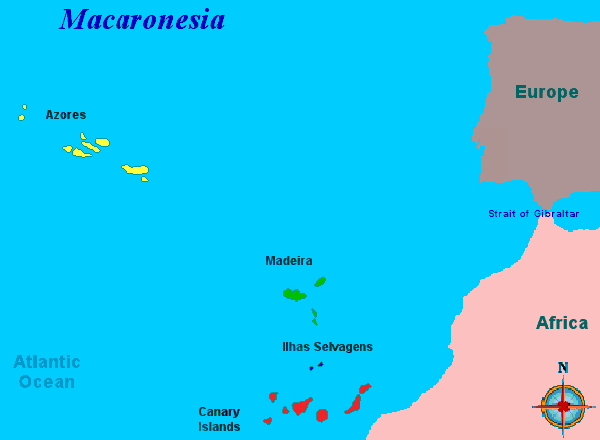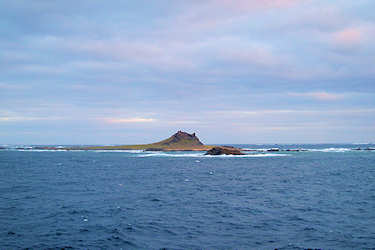Macaronesia

Historie
Macaronesia is a modern collective name for several groups of islands in the North Atlantic Ocean near
Europe and North Africa. The name comes from the Greek for "islands of the fortunate", a term used by
Ancient Greek geographers for islands to the west of the Straits of Gibraltar.
Azores
The Archipelago of the Azores is composed of nine volcanic islands situated in the middle of the North Atlantic Ocean,
and is located about 1.500 km West from Lisbon and about 3.900 km East from the east coast of North America.
The islands, and their economic exclusion zone, form the Autonomous Region of the Azores, one of the two autonomous
regions of Portugal.
Officially, the first islands were "discovered" in the 15th century (in 1431) by Gonçalo Velho Cabral a
Captain in the service of Infante D. Henrique. (Henry the Navigator)
At some point, following the discovery of Santa Maria, sheep were let loose on the island before settlement actually
took place. This was done to supply the future settlers with food because there were no large animals on the island.
Settlement did not take place right away, however. There was not much interest among the Portuguese people in an
isolated archipelago hundreds of miles from civilization. But patiently Cabral gathered resources and settlers for
the next three years (1433–1436) and sailed to establish colonies on Santa Maria first and then later on São
Miguel.
Canary Islands
The Canary Islands are a Spanish autonomous community and an outermost region of the European Union.
The islands were visited by the Phoenicians, the Greeks, and the Carthaginians. According to
the 1st century AD Roman author and philosopher Pliny the Elder, the archipelago was found to be uninhabited
when visited by the Carthaginians under Hanno the Navigator, but that they saw ruins of great buildings.
When the Europeans began to explore the islands, they encountered several indigenous populations living at
a Neolithic level of technology. Although the history of the settlement of the Canary Islands is still unclear,
there is indication that at least some of these inhabitants shared a common origin with the Berbers of northern
Africa. The pre-colonial inhabitants came to be known collectively as the Guanches
During the Middle Ages, the islands were visited by the Arabs for commercial purposes. The Muslim navigator
Ibn Farrukh, from Granada, is said to have landed in "Gando" (Gran Canaria) in February 999, visiting a king
named Guanarigato.
In 1402, the Castilian conquest of the islands began, with the expedition of French explorers Jean de
Béthencourt and Gadifer de la Salle, nobles and vassals of Henry III of Castile, to Lanzarote.
From there, they conquered Fuerteventura (1405) and El Hierro. Béthencourt received the title King of the Canary
Islands, but still recognized King Henry III as his overlord.
Madeira
Madeira, along with Desertas and Porto Santo comprises the other Autonomous region of Portugal.
Much like the Azores, it is clear that some knowledge of Atlantic islands, such as Madeira, existed before the
discovery and settlement of these lands, as the islands appear on maps as early as 1339
Officially, in 1418, two captains under service to Prince Henry the Navigator, João Gonçalves Zarco
and Tristão Vaz Teixeira, were driven off-course by a storm to an island which they named Porto Santo
(English: holy harbour); the name was bestowed for their gratitude and divine deliverance from a possible shipwreck
by the protected anchorage. The following year, an organized expedition, under the captaincy of Zarco and Vaz
Teixeira, was sent to this new land, and along with captain Bartolomeu Perestrello, to take possession of
the island on behalf of the Portuguese crown. Consequently, the new settlers discovered "a heavy black
cloud suspended to the southwest", which when explored they discovered the larger island of Madeira.
Ilhas Selvagens
The archipelago is administered by the Portuguese municipality of Funchal (Madeira) and are designated a
Nature Reserve.
I visited Macaronesia in mei 2010.
It was the end of the West Africa Pelagic
On that trip i have seen
Canary Islands (El Hierro/La Gomera)
Ilhas Selvagens
Madeira and Desertas
Please let me know when you're having questions.
i would be pleased to help you.
Things to do and other tips
